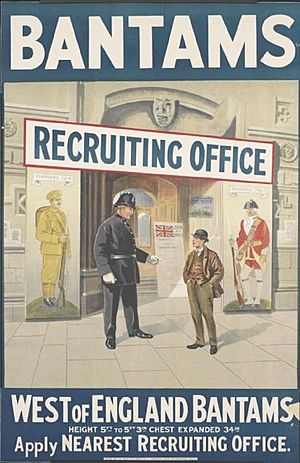Bantam (military) facts for kids
A bantam was a special kind of soldier in the British Army during the First World War. These soldiers were shorter than the usual army rules allowed. Normally, a soldier had to be at least 5 feet 3 inches (160 cm) tall. But for Bantams, the rule was changed to 5 feet (152 cm). This meant that many strong, healthy young men who were just a bit shorter could still join the army and fight for their country.
Contents
Bantam Soldiers: Small but Mighty
Bantam units were often formed in places where people worked hard jobs, like in factories or coal mines. In these areas, being shorter didn't mean you were weak. In fact, many of these men were very strong and fit.
Where the Name "Bantam" Came From
The name "bantam" comes from a town called Bantam in Indonesia. This town was known for a small type of chicken called a bantam chicken. The word "bantam" was also used in boxing for a lighter weight class called "bantamweight." This shows that even though they were smaller, they were known for being tough and powerful.
How the First Bantam Units Started
The very first "bantam battalions" were created in a town called Birkenhead, in Cheshire, England. This happened because a man named Alfred Bigland, who was a MP (a government leader), heard a story. A group of miners, who were too short for the army, had tried to join up everywhere but were turned away. One miner was so upset that he offered to fight anyone to prove he was strong enough to be a soldier!
Alfred Bigland was angry that these brave, healthy men were being rejected just because of their height. He asked the War Office (the part of the government that managed the army) if he could create a special fighting unit for shorter men.
Joining the Bantams
When the War Office said yes, news spread quickly across the country. Many men who had been told they couldn't fight rushed to Birkenhead. In November 1914, about 3,000 men were accepted into two new bantam battalions. To join, men had to be between 4 feet 10 inches (147 cm) and 5 feet 3 inches (160 cm) tall. They also had to have a chest size that was an inch (2.5 cm) bigger than the usual army rule. This showed how strong they were.
Heroes and Hard Battles
The Bantam soldiers became local heroes. The newspaper in Birkenhead, The Birkenhead News, even gave them special enamel badges that said "BBB" – which stood for "Bigland's Birkenhead Bantams."
These units were soon renamed the 15th and 16th Battalions of the Cheshire Regiment. They went through very tough training. They fought in some of the hardest battles of the war, like the Battle of Arras in 1917. Another bantam unit was the 14th Battalion (West of England) of the Gloucestershire Regiment, which was formed in 1915 and sent to France in 1916.
Eventually, two whole army groups, called divisions (the 35th and the 40th), were made up of Bantam men. These divisions faced terrible losses, especially during the Battle of Bourlon.
Changes Over Time
As the war went on, many Bantam soldiers were lost in battle. Some were moved to special army groups, like those who dug tunnels or worked with tanks. Also, the army started using conscription, which meant all men had to join, no matter their height. Because of this, taller men started to join the Bantam units as replacements. Over time, the Bantam units became very similar to all the other British army divisions.
See also
- 143rd Battalion (British Columbia Bantams), CEF
- 216th Battalion (Bantams), CEF


